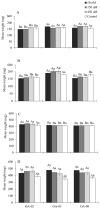In Silico and In Vivo Evaluation of Synthesized SCP-2 Inhibiting Compounds on Life Table Parameters of Helicoverpa armigera (Hübner)
- PMID: 36555079
- PMCID: PMC9782802
- DOI: 10.3390/insects13121169
In Silico and In Vivo Evaluation of Synthesized SCP-2 Inhibiting Compounds on Life Table Parameters of Helicoverpa armigera (Hübner)
Abstract
For environment-friendly, safe and nonpersistent chemical control of a significant polyphagous insect pest, Helicoverpa armigera, discovery of growth-regulating xenobiotics can offer a sustainable alternative to conventional insecticides. For this purpose, chemically synthesized compounds to inhibit sterol carrier protein (SCP-2) function using in silico and in vivo assays were evaluated to estimate their impact on the survivals and lifetable indices of H. armigera. From nine chemically synthesized compounds, OA-02, OA-06 and OA-09 were selected for this study based on binding poses mimicking cholesterol, a natural substrate of sterol carrier protein and molecular dynamics simulations. In vivo bioassays revealed that all compounds significantly reduced the larval and pupal weight accumulations and stadia lengths. Subsequently, the pupal periods were prolonged upon treatment with higher doses of the selected compounds. Moreover, OA-09 significantly reduced pupation and adult emergence rates as well as the fertility of female moths; however, fecundity remained unaffected, in general. The life table parameters of H. armigera were significantly reduced when treated with OA-09 at higher doses. The population treated with 450 μM of OA-09 had the least net reproductive rates (Ro) and gross reproductive rate (GRR) compared to the control population. The same compound resulted in a declining survival during the early stages of development coupled with reduced larval and pupal durations, and fertility. These results have a significant implication for developing an effective and sustainable chemical treatment against H. armigera infestation.
Keywords: MD simulations; SCP-2 inhibitor; life table; molecular docking; synthetic compounds.
Conflict of interest statement
The authors have no conflict of interest to declare that are relevant to the content of this article.
Figures





References
-
- Leong W.-H., Teh S.-Y., Hossain M.M., Nadarajaw T., Zabidi-Hussin Z., Chin S.-Y., Lai K.-S., Lim S.-H.E. Application, monitoring and adverse effects in pesticide use: The importance of reinforcement of Good Agricultural Practices (GAPs) J. Environ. Manag. 2020;260:109987. doi: 10.1016/j.jenvman.2019.109987. - DOI - PubMed
-
- Meister R.T. Farm Chemicals Handbook ’92. Meister Publishing Co.; Willoughby, OH, USA: 1992.
-
- Baker N.T., Stone W.W. Estimated Annual Agricultural Pesticide Use for Counties of the Conterminous United States, 2008–2012. US Geological Survey; Reston, VA, USA: 2015.
LinkOut - more resources
Full Text Sources
Research Materials

